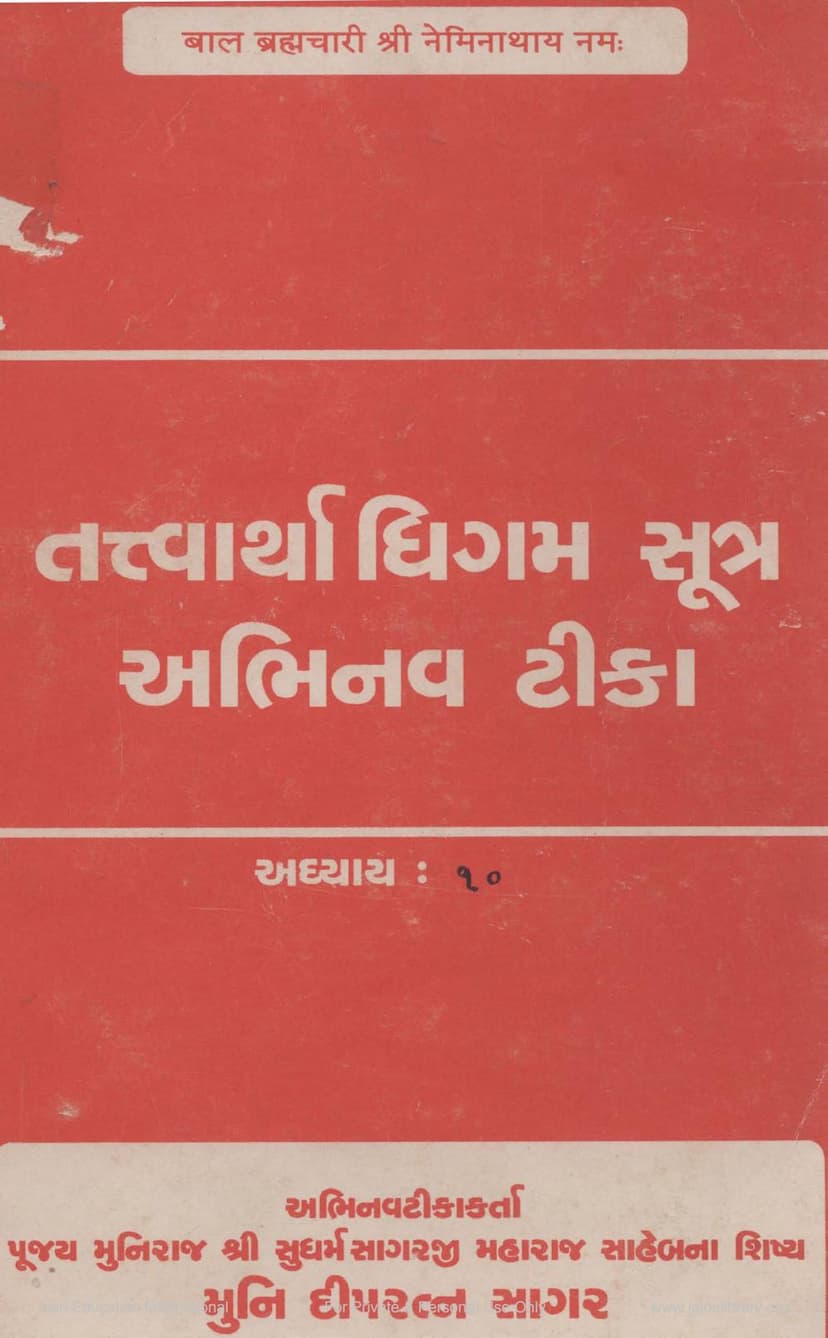Tattvarthadhigam Sutra Abhinav Tika Adhyaya 10
Added to library: September 2, 2025

Summary
This document is the 10th chapter of the "Tattvarthadhigam Sutra Abhinav Tika" by Acharya Umashwati, with a commentary by Muni Deepratnasagar. The chapter focuses on the path to liberation (Moksha) and the nature of the liberated soul (Siddha).
Here's a breakdown of the chapter's content:
Chapter 10: Path to Liberation and the Nature of the Liberated Soul
The chapter begins by summarizing the preceding nine chapters, explaining how each element (Tattva) has been progressively elaborated. Chapter 10, being the final one, is dedicated to the ultimate goal: Moksha.
Key Themes and Concepts Covered in Chapter 10:
-
The Genesis of Omniscience (Kevalgyan) and Omniscience (Kevaldarshan) (Sutra 1):
- It explains that before attaining Moksha, one must achieve Kevalgyan (complete knowledge) and Kevaldarshan (complete perception).
- This is achieved through the destruction of Mohaniya Karma (delusion-inducing karma) and the shedding of Gnana-avaraniya (knowledge-obscuring), Darshana-avaraniya (perception-obscuring), and Antaraya (obstructing) karmas.
- The text details the specific karmic roots that, when destroyed, lead to the manifestation of omniscience and omniscient perception. It emphasizes the destruction of Mohaniya karma as a primary step.
-
The Nature of Absolute Karma Annihilation (Sutra 2):
- This sutra explains the conditions for the complete cessation of karma from the soul.
- It states that the absence of the causes of bondage (bandha hetu) and the process of shedding karma (nirjara) lead to the ultimate annihilation of karma.
- The text identifies the five causes of bondage (mithyatva, avirati, pramad, kashaya, yoga) and highlights how their absence, coupled with austerities and practices leading to karma shedding, results in absolute karma annihilation.
-
The Definition and Attainment of Moksha (Sutra 3):
- Moksha is defined as the complete annihilation of all karmas.
- The text clarifies that even after the destruction of the four "dhatii" karmas (Mohaniya, Gnana-avaraniya, Darshana-avaraniya, Antaraya), the remaining four "adhatii" karmas (Vedayaniya, Nama, Gotra, Ayushya) must also be shed for complete liberation.
- Upon the complete destruction of all karmas, the soul achieves its pure, innate nature of infinite knowledge, perception, bliss, and power.
-
Moksha and the State of the Liberated Soul (Sutra 4):
- This sutra elaborates on the states (bhavas) that must cease for Moksha.
- It states that Moksha is attained by the absence of the Opashamika (subsiding), Kshaya-opashamika (subsiding-annihilating), and Audayika (maturing) bhavas.
- However, it specifies that the Kshayika (annihilating) bhavas, such as Kevala-samaykatva (absolute right faith), Kevala-gyana (absolute knowledge), Kevala-darshan (absolute perception), and Siddhatva (liberated state), remain and are inherent to the liberated soul.
-
The Upward Journey to the Abode of Siddhas (Sutra 5):
- Immediately after the annihilation of all karmas and the cessation of the relative bhavas, the liberated soul ascends upwards towards the Loka-kanta (the end of the universe).
- This upward movement is instantaneous and occurs simultaneously with the shedding of the physical body and achieving the Siddha state.
-
The Reasons for the Upward Movement (Sutra 6):
- This sutra explains the causes behind the upward movement of the liberated soul.
- These reasons include:
- Purva-prayoga: The residual momentum from past actions.
- Asangatva: The non-attachment and insulation from karmic matter.
- Bandha-chheda: The severance of all karmic bonds.
- Tatha Gati-parinam: The inherent upward nature of the soul's movement.
- The commentary uses analogies like the potter's wheel and the gourd in water to illustrate these principles.
-
The Attributes of the Siddha Soul through Twelve Analytical Categories (Sutra 7):
- The final sutra of the chapter and the entire Tattvarthasutra lists twelve analytical categories (anuyoga-dvaras) to understand the Siddha soul:
- Kshetra (Space): Where they reside (Siddhashila).
- Kala (Time): When they attain liberation.
- Gati (Movement): Their upward journey.
- Linga (Mark/Characteristic): The absence of any distinguishing marks.
- Tirtha: Whether they attained liberation during the presence of a Tirthankara or not.
- Charitra: The type of conduct they followed.
- Pratyeka-buddha-bodhita: Whether they attained knowledge independently or through a teacher.
- Jnana (Knowledge): The type of knowledge they possessed before liberation.
- Avagahana (Stature): Their height.
- Antara (Interval): The time between successive liberations.
- Sankhya (Number): The number of souls liberated at a given time.
- Alpa-Bahutva (Less-More): The relative proportion of Siddhas across different categories.
- The final sutra of the chapter and the entire Tattvarthasutra lists twelve analytical categories (anuyoga-dvaras) to understand the Siddha soul:
The chapter concludes by reiterating the significance of understanding these Tattvas and the path to Moksha, emphasizing the role of right faith, right knowledge, and right conduct. The "Abhinav Tika" provides detailed explanations, examples, and scriptural references for each sutra, making the complex philosophical concepts accessible. The appendices at the end include various concordances and cross-references to other Jain scriptures, enhancing the scholarly value of the work.